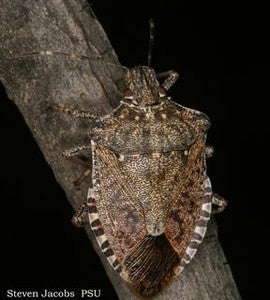Brown Marmorated Stink Bug: An Emerging Agricultural Pest
The Brown Marmorated Stink Bug (BMSB) is a relatively new pest problem, but can be a serious, season long threat to anyone growing food crops. They really like to eat sweet, thin skinned crops such as heirloom tomatoes, green peppers, berries, corn, soybeans, and lots of different fruit crops. They can be a problem on flowers as well. Most people know them simply as a pest in the home because they like to overwinter in warm places, and they literally do stink (because they release a chemical from scent glands on their thorax). But in many parts of the country their populations have recently exploded and many entomologists expect them to be a serious plant pest this coming growing season.
History: Native to Western Asia, the BMSB is though to have been introduced into the U.S. in Pennsylvania in the late 1990’s. They have quickly spread from the Mid-Atlantic states to many regions of the country, and because they have no natural enemies, their populations are expected to continue to grow and spread.
Identification: BMSB is a ‘true bug’, with the scientific name Halyomorpha halys. They range in size from the first instar at 2.4 mm to the fifth instar that is 12 mm in length. Adults are quite large, up to 17 mm (more than half an inch). They are mottled brown on the upper body, and white with gray or black markings. Their eyes are dark reddish brown. They have patches of coppery or bluish-metallic colored depressions on their head, and white stripes on their antennae. Tare the typical  “shield” shape of other stink bugs, and are almost as wide as they are long. Eggs are round and white and are typically seen in clusters on the underside of leaves.
“shield” shape of other stink bugs, and are almost as wide as they are long. Eggs are round and white and are typically seen in clusters on the underside of leaves.
Damage: BMSB is a sucking insect that uses its proboscis to pierce the host plant to feed. Feeding results, in part, in the formation of small, necrotic areas just under the skin and sometimes on the outer surface of fruits and leaves of it’s hosts. It can cause characteristic cat-facing injury in fruits such as apples and peaches.
Control: Entomologists are still exploring potential control mechanisms, and currently there is no consensus on what chemical controls are most effective. The effectiveness of various insecticide classes to control of BMSB is evaluated in Nielsen et al. (2008) and a brief summary of his results is presented below. Though Pyrethrioid insecticides have shown effectiveness in other laboratory tests, they can cause other problems in IPM programs for fruit crops. Organic row crop growers have reported using row covers effectively. Some growers have reported effective use of companion planting using marigolds, garlic and tansy. And others use trap crops such as buckwheat, sunflower, or sorghum. There is also now a commercial pheromone trap produced by a AgBio (https://www.agbio-inc.com/1/post/2011/02/stink-bug-trap-debut.html) developed in partnership with USDA (Thanks to The Bug Lady for pointing this out). Scouting is extremely important so that the problem can be identified before it gets out of hand. It is likely that control measures similar to those used for other stink bugs and related insects will be adapted to the specific life cycle, behavior patterns, and product sensitivity of BMSB, but agricultural scientists are still in the very early stages of learning about what works and what doesn’t.
Resources: Michigan State University has an information alert with lots of good information available at https://www.ipmnews.msu.edu/fruit/Fruit/tabid/123/articleType/ArticleView/articleId/3247/Brown-Marmorated-Stink-Bug.aspx. Dr. Tracy Leskey, entomologist at the U.S. Department of Agriculture’s Appalachian Fruit Research Station in Kearneysville is an expert on the Brown Marmorated Stink Bug, and she co-chairs a special USDA working group looking for ways to deal with the problems presented by this emerging pest. You can see an excellent video presentation by her at https://freshandlocalcsa.com/videopage.html.
Reference: Nielsen AL, Shearer PW, Hamilton GC. 2008. Toxicity of insecticides to Halyomorpha halys (Hemiptera: Pentatomidae) using glass-vial bioassays. Journal of Economic Entomology 101: 1439-1442. Excerpt from abstract: Pyrethroid insecticides, especially bifenthrin, caused mortality against H. halys at low doses, with LC50 values of 0.03–0.49 (μg [AI]/cm2)(mg body mass−1). Three nicotinoids were tested against adults with LC50 values ranging between 0.05 and 2.64 (μg [AI]/cm2)(mg body mass−1). Phosmet had LC50 values that were up to 3.6-fold higher than other classes of insecticides tested. Fifth instars of H. halys were evaluated against selected chemicals, and they were generally susceptible at lower rates than the adults. Due to significant differences in weight, males and females were individually weighed, tested, and analyzed separately. Sex-related differences in susceptibility were found in the responses to thiomethoxam with males being less susceptible despite having a smaller body mass. Note: “LC50” refers to the concentration required to kill 50% of insects treated within a given time.
Here’s one sure fire way to take care of the pest:



 Your Privacy Choices
Your Privacy Choices
Because BMSB is a serious threat to US food supplies perhaps we should consider bringing back some of the previously banned materials like Diazinon and Chlordane to combat it until we can develop better measures. https://pestcontrolcenter.com/blog/?p=678